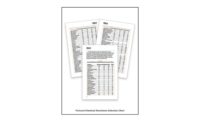A CDC- NIOSH Science Blog post:
Accurate and efficient assessments of working posture

 Musculoskeletal disorders (MSDs) account for roughly one-third of workplace illness and injuries in the United States. According to Liberty Mutual Insurance Company, overexertion injuries, which include those from work-related lifting, pushing, pulling, holding, carrying, or throwing, cost U.S. businesses $14.2 billion in direct costs in 2013. To address the burden of preventable musculoskeletal and overexertion injuries, practitioners in the fields of Occupational Safety, Industrial Hygiene and Ergonomics need workplace assessment methods that are both accurate (valid) and time efficient. This need was highlighted in a 2008 NIOSH exposure assessment workshop in which a health/safety/ergonomics practitioner said:
Musculoskeletal disorders (MSDs) account for roughly one-third of workplace illness and injuries in the United States. According to Liberty Mutual Insurance Company, overexertion injuries, which include those from work-related lifting, pushing, pulling, holding, carrying, or throwing, cost U.S. businesses $14.2 billion in direct costs in 2013. To address the burden of preventable musculoskeletal and overexertion injuries, practitioners in the fields of Occupational Safety, Industrial Hygiene and Ergonomics need workplace assessment methods that are both accurate (valid) and time efficient. This need was highlighted in a 2008 NIOSH exposure assessment workshop in which a health/safety/ergonomics practitioner said:
“I’m a consultant, and ….we have to do 450 (facilities) in four years. So speed is essential, and we are using the risk assessment checklist, semi-quantitative measures to estimate risk.”
This practitioner was indicating two important points. First, because he was responsible for conducting a large number of worksite ergonomic assessments, an efficient risk-assessment method was important. Second, like other OS&H practitioners conducting risk assessments, he relies on semi-quantitative observation-based methods to evaluate risk factors, such as postural stress. Even though technology for assessing body kinematics (motion) continues to advance, use of observation-based approaches is commonplace among practitioners conducting workplace assessments of risk factors for musculoskeletal and overexertion injury. While often relied upon, these methods are not standardized, nor were they systematically developed.
These points were part of the motivation for the recent publication Observation-Based Posture Assessment: Review of Current Practice and Recommendations for Improvement; developed by NIOSH and colleagues at the University of Windsor affiliated with the Canadian Centre of Research Expertise for the Prevention of Musculoskeletal Disorders, CRE-MSD. This new document, intended to assist practitioners, is based on a number of recent studies that systematically determined an optimal observational framework for classifying postural stresses in the workplace, among multiple levels of severity. This optimal framework considers the accuracy (validity) of the posture assessment: that is, how many errors are made, and the size of the errors, in visually estimating posture. The optimal framework also considers efficiency: that is, how fast the observer can visually estimate and classify posture among multiple levels.
Click here to read the rest of the blog post, which includes graphics showing degrees of posture.
Looking for a reprint of this article?
From high-res PDFs to custom plaques, order your copy today!







